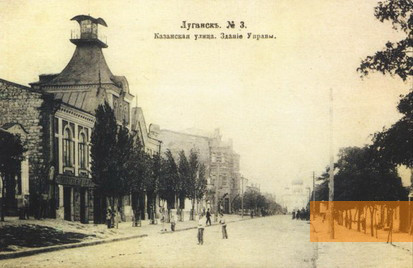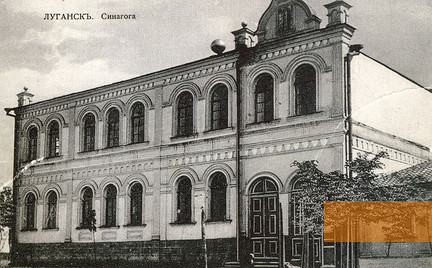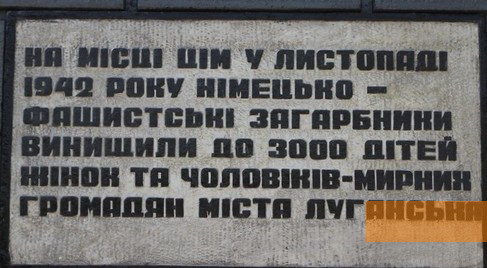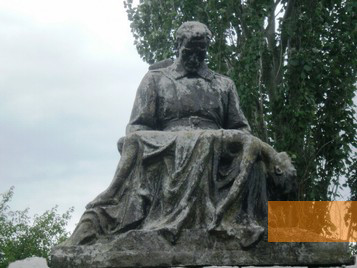Since 1945 a memorial in the village of Vydnyy near the city of Luhansk remembers the Jews from the city and its surroundings who were murdered during the German occupation.
Luhansk (Russian: Lugansk) is the capital of the same-named administrative unit in eastern Ukraine. It was founded at the end of the 18th century and from 1953 to 1958 and from 1970 to 1992 was calles Voroshilovgrad in honour of the Soviet Defence Secretary during the Stalin era. The city developed into an important centre of heavy industry. Jews lived in Luhansk since the end of the 19th century, by 1926 they accounted for 10% of the population. In the 1930s most of the Jews worked in heavy industry or rail transport and the number of Jewish inhabitants rose to 11,000.
The German Wehrmacht occupied the city not until a year after their attack on the Soviet Union on July 17, 1942. The majority of the Jewish population fled to the interior of the Soviet Union beforehand. In September 1942 the German authorities counted 1,038 Jews. On November 1, 1942 the German occupiers rounded up the Jews on the central square and carried them to the village Ostraya Mogila (Ukrainian: Hostra Mohyla) southeast of the town (today: village of Vydnyy). The men of the Einsatzgruppe (mobile killing unit) C shot the children, women and men and hastily buried them in antitank ditches. Some were suffocated in gas vans. Among the victims were about 100 Jews from Alchevsk and other nearby places. About three weeks later Luhansk was recaptured by the Red Army.
The German Wehrmacht occupied the city not until a year after their attack on the Soviet Union on July 17, 1942. The majority of the Jewish population fled to the interior of the Soviet Union beforehand. In September 1942 the German authorities counted 1,038 Jews. On November 1, 1942 the German occupiers rounded up the Jews on the central square and carried them to the village Ostraya Mogila (Ukrainian: Hostra Mohyla) southeast of the town (today: village of Vydnyy). The men of the Einsatzgruppe (mobile killing unit) C shot the children, women and men and hastily buried them in antitank ditches. Some were suffocated in gas vans. Among the victims were about 100 Jews from Alchevsk and other nearby places. About three weeks later Luhansk was recaptured by the Red Army.
According to the official Soviet investigating commission more than 1,900 Jews were murdered in the village of Ostraya Mogila altogether. Another site of mass shooting is located east of the city in the village of Ivanyshchiv Yar. According to the Commission as much as 1,900 people were murdered there as well. 58% of the murdered civilians in Luhansk were Jews.
In 1959 the city had a Jewish population of 5,500. Most of them emigrated from the Ukraine in the 1990s, many of them moved to Germany.
After the war only few of the victims could be identified. In 1945 a memorial was erected on the site of the shooting. Referring to the Kiev massacre of September 1941 it is also called the »Babi Yar of Luhansk«. To this day the grave is not completely enclosed, there are a number of plots and houses on the site. The memorial is composed of a concrete arch bearing the inscription »We don't forget, we don't forgive« which allows entry to a square paved with stone slabs. The pedestal of the memorial showing a soldier holding a dead child in his arms bears the inscription: »On this site in November of 1942 German fascist intruders murdered up to 3,000 children, women and civilians from Luhansk«. Over time the memorial was repeatedly damaged, some of the slabs with the engraved names of victims were stolen, the remaining are faded caused by the weather. The memorial is located 200 meters off the main road to the airport in the village of Vydnyy. In 2015 the memorial was restored. In September 2016 a memorial of the same name was erected nearby, on the initiative of the internationally not recognised »People's Republic of Lugansk« and the organisation »Mir Luganshine«. According to local media it shall commemorate the 500 people killed during the conflict in Luhansk and who are buried in a mass grave at the memorial.
After the war only few of the victims could be identified. In 1945 a memorial was erected on the site of the shooting. Referring to the Kiev massacre of September 1941 it is also called the »Babi Yar of Luhansk«. To this day the grave is not completely enclosed, there are a number of plots and houses on the site. The memorial is composed of a concrete arch bearing the inscription »We don't forget, we don't forgive« which allows entry to a square paved with stone slabs. The pedestal of the memorial showing a soldier holding a dead child in his arms bears the inscription: »On this site in November of 1942 German fascist intruders murdered up to 3,000 children, women and civilians from Luhansk«. Over time the memorial was repeatedly damaged, some of the slabs with the engraved names of victims were stolen, the remaining are faded caused by the weather. The memorial is located 200 meters off the main road to the airport in the village of Vydnyy. In 2015 the memorial was restored. In September 2016 a memorial of the same name was erected nearby, on the initiative of the internationally not recognised »People's Republic of Lugansk« and the organisation »Mir Luganshine«. According to local media it shall commemorate the 500 people killed during the conflict in Luhansk and who are buried in a mass grave at the memorial.
- Name
- Ne sabudemo, ne prostimo
- Address
-
ul. Sadalnikova
91000 Luhansk - Open
- The memorial is accessible at all times.







